Red light for treatment of dry macular degeneration (PBM)

Blog vol 5.22. Red light for treatment of dry macular degeneration (PBM)
Last weekend, I had the pleasure of attending the annual University of Waterloo School of Optometry and Vision Science, three-day conference on the latest research in eye care.
One topic of conversation was the uses and benefits of photobiomodulation (PBM).
PBM, what is it?
PBM uses low energy light, in LED form at the 670 nanometre(nm) wavelength, as a therapy for retinal problems, primarily dry macular degeneration, but possibly other conditions as well.
How does it work?
As we get older, our retinal cells deteriorate (surprised?) and the key in the deterioration process appears to be the mitochondria (the powerhouse for the cell) in the receptors, rods and cones. The receptors cells are constantly firing, requiring high levels of energy, and placing huge demands on the mitochondria. It has been found that judiciously applied infrared light actually helps restore these cell organelles.
Does PBM work?
The latest study, Lightsite III (see here) used a clinical instrument called the Valeda, with three different wavelengths, 590 nm, 660 nm and 850 nm. This was the largest and most long-term study to date: 148 eyes over two years. The results were promising. Much more work needs to be done here.
Red light therapy, though still somewhat controversial, also can be used to enhance healing and cell repair as well as reduce inflammation body-wide. The Vielight Rx Plus, for example, was approved in Canada for use with covid-19 patients in May, 2023 (Read more here).
“Non-invasive, portable, excellent for home and travel use, NOT to replace prescribed treatments and doctor’s recommendations” — exactly.
There, of course, is no guarantee of results, but when your vision is getting worse, it’s worth a try.
Risks?
There are no known long-term adverse risks. The treatment involves the application of low energy light, i.e. red light, to the eyes at regular intervals for relatively short times, that is all. Some negative side effects are always a possibility such as surrounding skin irritation or headache, however, the results are promising and with no other effective treatment on the horizon, the safe use of Infrared light appears to be a viable option.
What does PBM treatment look like practically?
There is in-office treatment with the Valeda, a sophisticated, office-sized machine which applies red light to the eye. This strikes me as impractical, way too cumbersome (and expensive, in money and time) for the regular, long-term application of this treatment. The take-home glasses are approved by Health Canada and make much more sense. You use them every other day for 3 minutes at a time. It is an ongoing treatment like taking your antioxidant supplements (which you should definitely continue to do).
Cost?
Unfortunately, while approved by Health Canada, there is no help from OHIP for this treatment.
I’m interested, what next?
Give us a call, come in for an appointment, and we will assess whether this is a treatment that you may benefit from and what your options are.
It is interesting that blue, high energy, light which we get from screens is potentially damaging to the eyes, especially in large quantity and red, low energy, light can be used to aid healing. Interesting. In light of this thought, blue light filters for people with retinal problems would also seem a good idea.
Continuing to research,
The good doctor






